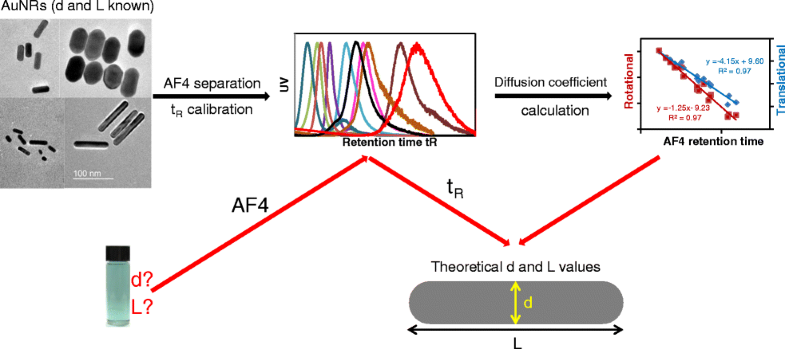Analytical and Bioanalytical Chemistry ( IF 4.3 ) Pub Date : 2018-09-07 , DOI: 10.1007/s00216-018-1325-y Hind El Hadri , Julien Gigault , Jiaojie Tan , Vincent A. Hackley
Applications of asymmetrical flow field-flow fractionation (AF4) continue to expand rapidly in the fields of nanotechnology and biotechnology. In particular, AF4 has proven valuable for the separation and analysis of particles, biomolecular species (e.g., proteins, bacteria) and polymers (natural and synthetic), ranging in size from a few nanometers to several micrometers. The separation of non-spheroidal structures (e.g., rods, tubes, etc.) with primary dimensions in the nanometer regime, is a particularly challenging application deserving of greater study and consideration. The goal of the present study was to advance current understanding of the mechanism of separation of rod-like nano-objects in the AF4 channel. To achieve this, we have systematically investigated a series of commercially available cetyltrimethylammonium bromide stabilized gold nanorods (AuNRs), with aspect ratios from 1.7 to 10. Results show clearly that the retention time is principally dependent on the translational diffusion coefficient of the AuNRs. Equations used to calculate translational and rotational diffusion coefficients (cylinder and prolate ellipsoid models) yield similarly good fits to experimental data. Well characterized gold nanorods (length and diameter by transmission electron microscopy) can be used as calibrants for AF4 measurements allowing one to determine the aspect ratio of nanorod samples based on their retention times.

ᅟ
中文翻译:

金纳米棒在不对称流场-流分离中的保留行为评估
在纳米技术和生物技术领域,非对称流场流分离(AF4)的应用继续迅速扩展。尤其是,AF4已被证明对于分离和分析大小从几纳米到几微米的颗粒,生物分子种类(例如蛋白质,细菌)和聚合物(天然和合成)具有重要价值。具有纳米尺度主要尺寸的非球形结构(例如,杆,管等)的分离是一项特别具有挑战性的应用,值得进一步研究和考虑。本研究的目的是促进当前对AF4通道中棒状纳米物体分离机理的了解。为达到这个,我们已经系统地研究了一系列市售的鲸蜡基三甲基溴化铵稳定的金纳米棒(AuNRs),长径比为1.7至10。结果清楚地表明,保留时间主要取决于AuNRs的翻译扩散系数。用于计算平移和旋转扩散系数的方程(圆柱和长椭球形模型)也可以很好地拟合实验数据。表征良好的金纳米棒(通过透射电子显微镜测得的长度和直径)可以用作AF4测量的校准物,从而可以根据其保留时间确定纳米棒样品的长宽比。结果清楚地表明,保留时间主要取决于AuNRs的翻译扩散系数。用于计算平移和旋转扩散系数的方程(圆柱和长椭球形模型)也可以很好地拟合实验数据。表征良好的金纳米棒(通过透射电子显微镜测得的长度和直径)可以用作AF4测量的校准物,从而可以根据其保留时间确定纳米棒样品的长宽比。结果清楚地表明,保留时间主要取决于AuNRs的翻译扩散系数。用于计算平移和旋转扩散系数的方程(圆柱和长椭球形模型)也可以很好地拟合实验数据。表征良好的金纳米棒(通过透射电子显微镜测得的长度和直径)可以用作AF4测量的校准物,从而可以根据其保留时间确定纳米棒样品的长宽比。

ᅟ


























 京公网安备 11010802027423号
京公网安备 11010802027423号